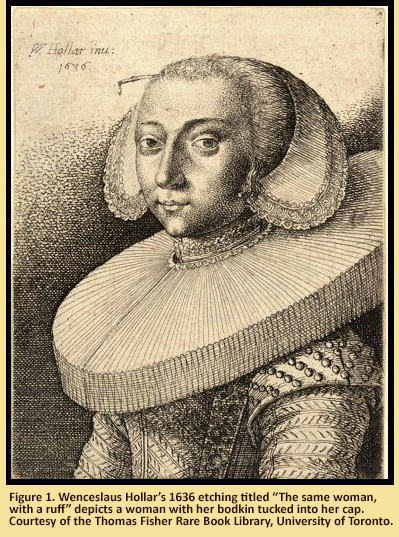Maryland Archaeological Conservation Laboratory
Main_Content
Curator's Choice 2008
Inscribed "SS" Bodkin
March 2008
By Sara Rivers Cofield, MAC Lab Federal Curator
 The Charles' Gift archaeological site was discovered in 1999, during U.S. Navy- sponsored excavations conducted aboard the Naval Air
Station, Patuxent River (Hornum et al. 2001). Archaeologists identified two different houses; one that appears to have been inhabited from
c. 1676-1694, and another that was presumably built as a replacement around 1694. Between the two structures was a large borrow pit where
builders dug up clay to make brick for the foundations of the 1690s structure. This pit was later filled with debris from the destruction
of the earlier house. Among the debris in the pit was a bodkin, inscribed with the initials “SS.”
The Charles' Gift archaeological site was discovered in 1999, during U.S. Navy- sponsored excavations conducted aboard the Naval Air
Station, Patuxent River (Hornum et al. 2001). Archaeologists identified two different houses; one that appears to have been inhabited from
c. 1676-1694, and another that was presumably built as a replacement around 1694. Between the two structures was a large borrow pit where
builders dug up clay to make brick for the foundations of the 1690s structure. This pit was later filled with debris from the destruction
of the earlier house. Among the debris in the pit was a bodkin, inscribed with the initials “SS.”
A bodkin is like a large, slightly blunted needle with a rectangular hole to accommodate ribbons and laces. In the 17th and 18th centuries,
bodkins were important personal items for women. They were primarily used to lace decorative trims, corsets, and drawstrings, but sometimes
women also displayed bodkins like jewelry by wearing them in their caps (Figure 1). Many women of high status owned inscribed silver
bodkins, often pierced with a second hole to string on a decorative bauble.
Historical research suggests that the Charles' Gift structures had been occupied by Nicholas and Susanna Sewall and their family, because
Nicholas Sewall would have come of age and inherited the parcel of land in 1676. The discovery of a bodkin with the initials “SS”
inscribed on it helps confirm this interpretation by acting as a poignant connection to Susanna Sewall (Figure 2).
Nicholas and Susanna Sewall were part of Maryland’s elite in the 1670s and 1680s. Nicholas' stepfather was Charles Calvert, governor of Maryland
who became the Third Lord Baltimore in 1676. The family fell on hard times in 1689, however, because Protestants overthrew the Catholic
Calvert proprietary that year, raiding Charles Calvert's home and forcing Nicholas to flee to Virginia.

Susanna Sewall's bodkin may reflect this hardship because elite women generally had professionally inscribed silver bodkins, but Susanna’s bodkin
was copper alloy with silver or tin plating, and her initials appear to be chiseled rather than neatly inscribed. It is possible that
Susanna had to trim the budget on her personal items while still keeping up appearances (Beaudry 2006).
| References |
|
| Beaudry, Mary C. |
| 2006 |
Findings: The Material Culture of Needlework and Sewing. Yale University Press, New Haven and London. |
|
| Hornum, Michael B., Andrew D. Madsen, Christian Davenport, John Clarke, Kathleen M. Child, and Martha Williams |
| 2001 |
Phase III Archaeological Data Recovery at Site 18ST704, Naval Air Station Patuxent River, St. Mary’s County, Maryland. Report Prepared for Tams Consultants, Inc., Arlington, Virginia. |
|